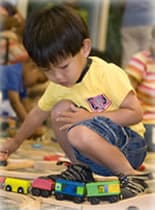Key points
- Disasters affect children differently than they do adults.
- Children have unique needs during and after disasters.

Children are different
Children's bodies are different from adults' bodies
- They are more likely to get sick or severely injured.
- They breathe in more air per pound of body weight than adults.
- They have thinner skin, and more of it per pound of body weight (higher surface-to-mass ratio).
- They have less fluid in their bodies, so fluid loss (e.g. dehydration, blood loss) can have a bigger effect on children.
- They breathe in more air per pound of body weight than adults.
- They are more likely to lose too much body heat.
- They spend more time outside and on the ground.
- They put their hands in their mouths more often than adults.
Children in an emergency
Children need help from adults in an emergency
- Children don't fully understand how to keep themselves safe.
- Older children and adolescents may take their cues from others.
- Young children may cry, scream, or become paralyzed with fear.
- They may not be able to explain what hurts or bothers them.
- They are more likely to get the care they need when they have parents or other caregivers around.
- Adults are required by law to make medical decisions for a child.
- Adults will sometimes have to make decisions with limited information on the ways some illnesses and medicines affect children.
Children's mental health
Mental stress from a disaster can be harder on children
- They feel less of a sense of control.
- They understand less about the situation.
- They have fewer experiences bouncing back from hard situations.
Content Source:
Office of Readiness and Response
